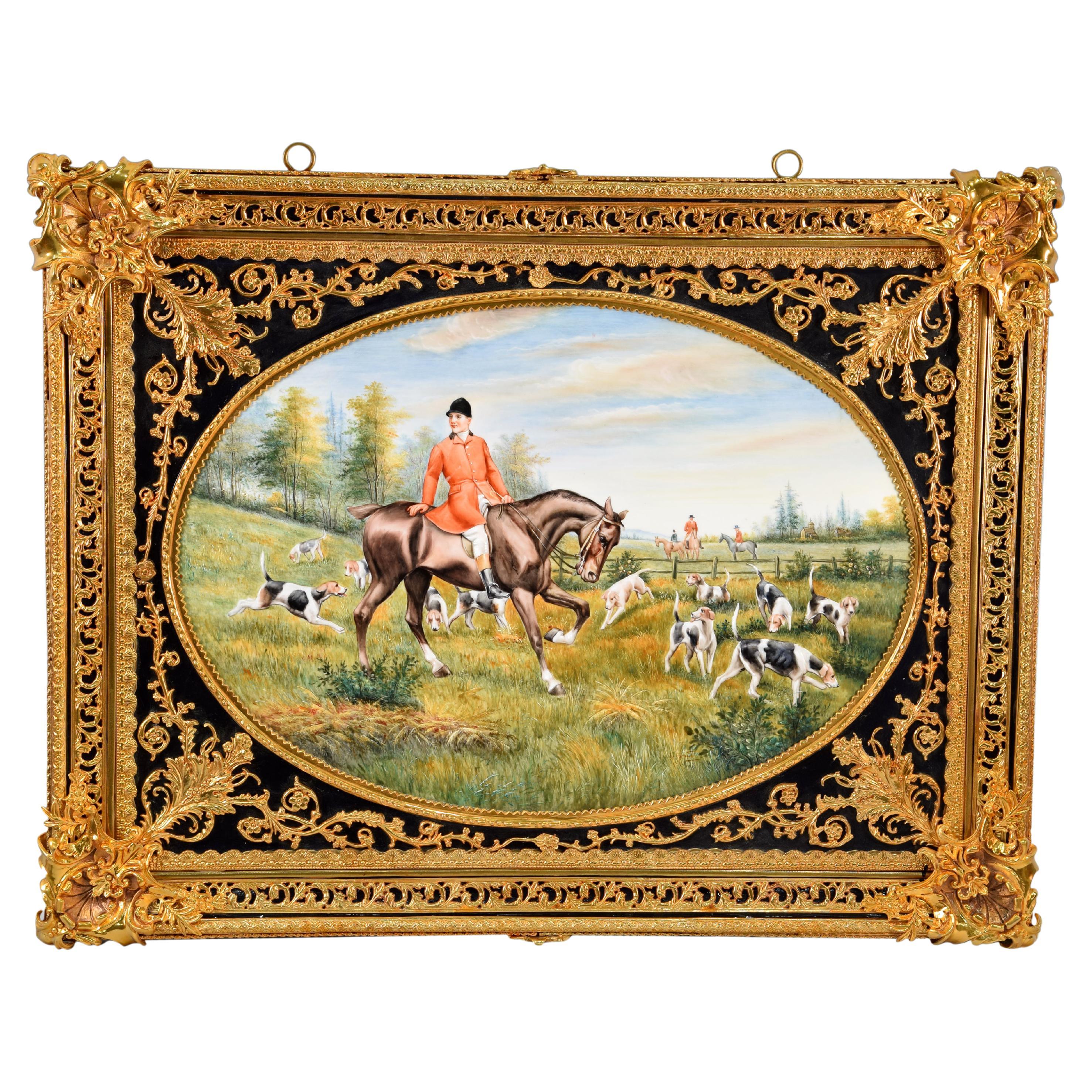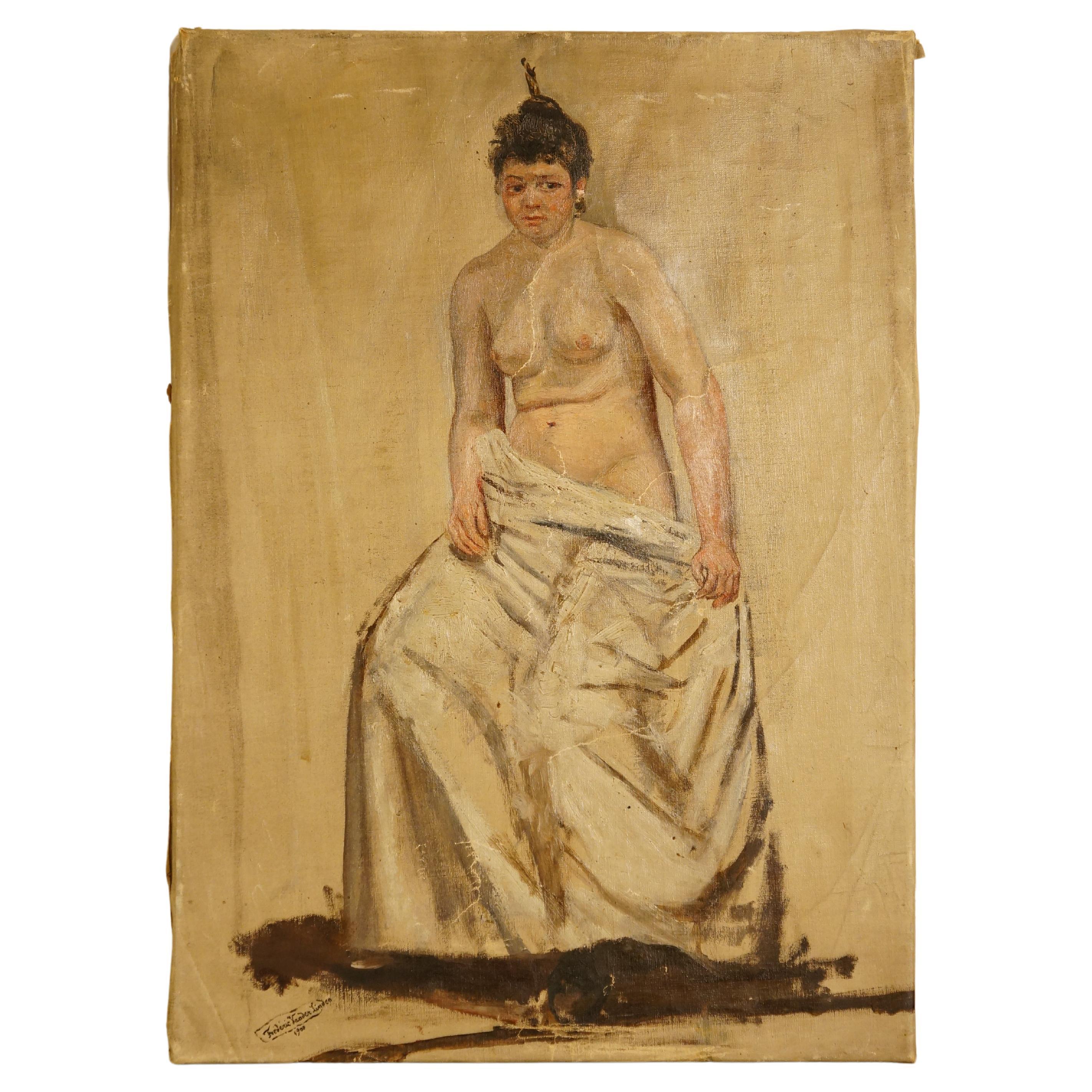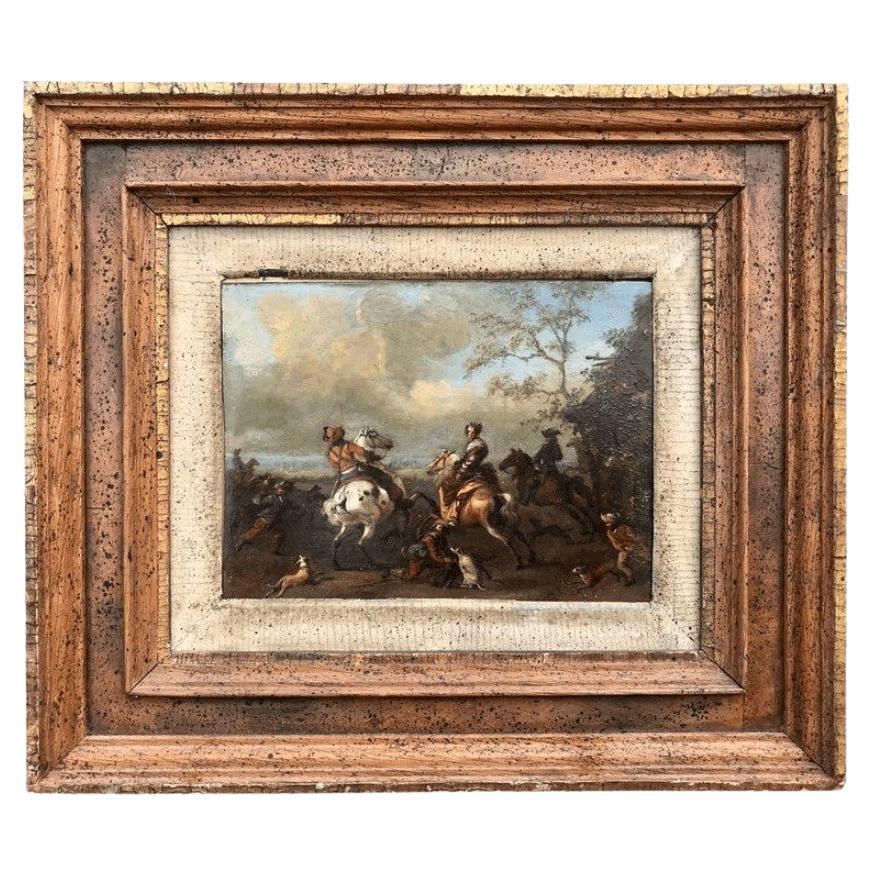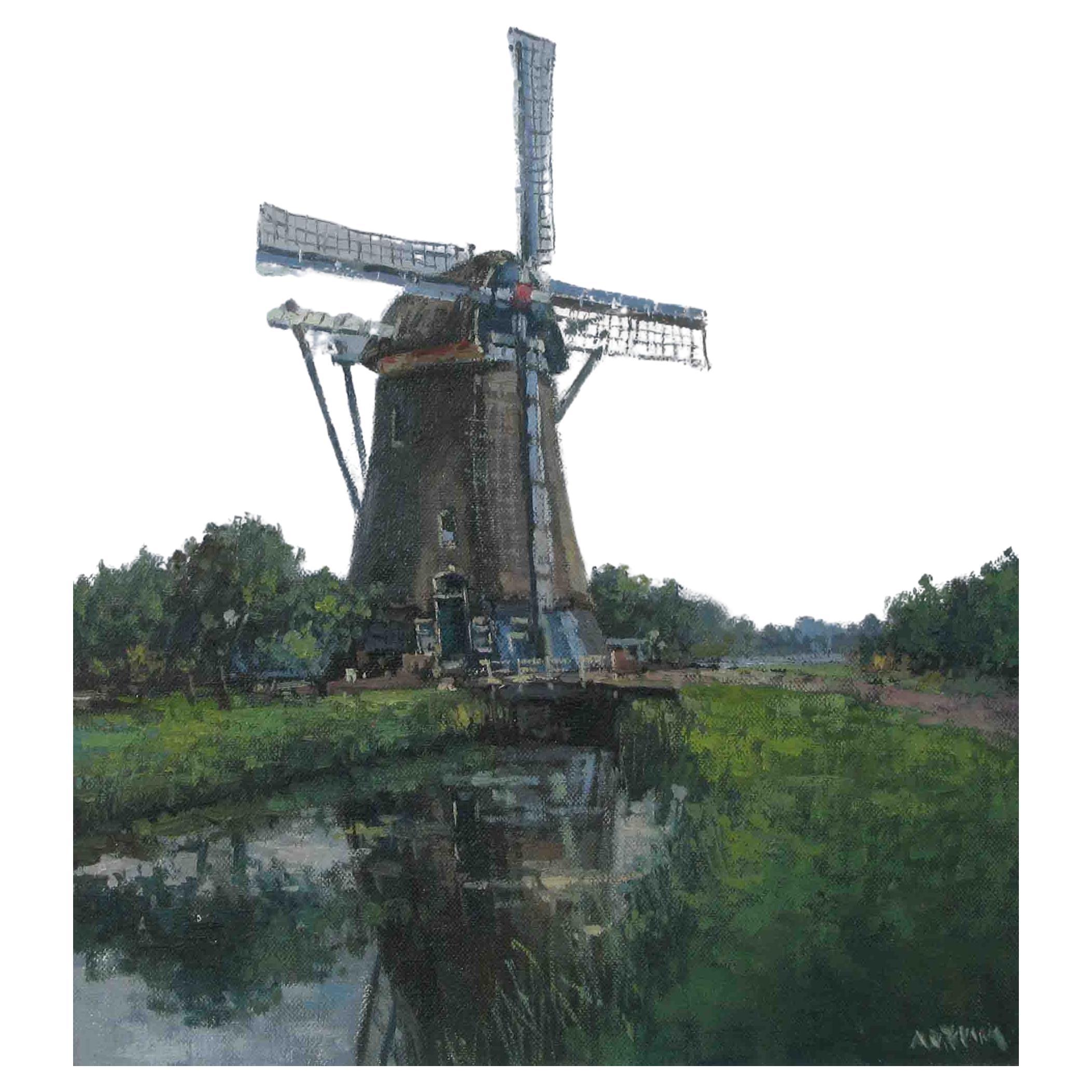Items Similar to After Pieter van Bloemen Oil on Canvas Hunting & Ruins Scene
Want more images or videos?
Request additional images or videos from the seller
1 of 8
After Pieter van Bloemen Oil on Canvas Hunting & Ruins Scene
About the Item
School of Pieter van Bloemen (Flemish, 1657-1720) oil on Canvas "Hunting & Ruins Scene". The capriccio scene depicting two male hunters in robes, one standing holding a musket, the other seated holding his prey, Roman ruins on one side and a large Village in the background, within an ebonized and parcel-gilt frame. Unsigned, circa 19th century.
Pieter van Bloemen, also known as Standaart (bapt. 17 January 1657 - 6 March 1720), first name also spelled Peter or Peeter, was a Flemish painter. He was a gifted landscape and animal painter and was very successful with his compositions depicting equestrian, animal and market scenes.
Van Bloemen was born in Antwerp. He was a pupil of Simon Johannes van Douw, according to some historians already from the age of 10. He became a master of the local Guild of Saint Luke in 1674 at the age of 17. He had two younger brothers who were also painters: Jan Frans and Norbert. At some point he travelled to Rome. This possibly happened in the year 1674 or later in the year 1689. He was in 1684 in Lyon in the company of the Dutch painters Adriaen van der Cabel and of Gillis Weenix. His brother Jan Frans joined him in Lyon.
A prolific painter, van Bloemen was at his best painting animals, although he also produced a wide range of landscape, genre, equestrian, military and history scenes. He carried on the tradition of Italianizing landscape paintings of the Roman Campagna representing inns, ruins and animals. A portion of his output paintings also stand in the tradition of the 'bamboccianti', a group of mainly Dutch and Flemish artists active in Rome whose small works depicted trivial or base subjects.
Canvas Height: 12 3/4 inches (32.4 cm)
Canvas Width: 16 5/8 inches (42.2 cm)
Frame Height: 20 inches (50.8 cm)
Frame Width: 24 inches (61 cm)
Frame Depth: 2 1/8 inches (5.4 cm)
- Dimensions:Height: 20 in (50.8 cm)Width: 24 in (60.96 cm)Depth: 2.13 in (5.42 cm)
- Style:Renaissance Revival (In the Style Of)
- Materials and Techniques:
- Place of Origin:
- Period:
- Date of Manufacture:circa 19th Century
- Condition:Repaired: Viewed under UV light there some minor touch ups. Please view all images. 585. Wear consistent with age and use. Minor losses. Minor fading. A beautiful painting. Some restoration and minor paint losses. Viewed under UV light there some minor touch ups. Please view all images.
- Seller Location:Los Angeles, CA
- Reference Number:
About the Seller
5.0
Vetted Seller
These experienced sellers undergo a comprehensive evaluation by our team of in-house experts.
Established in 1982
1stDibs seller since 2016
114 sales on 1stDibs
Typical response time: <1 hour
- ShippingRetrieving quote...Ships From: Los Angeles, CA
- Return PolicyThis item cannot be returned.
More From This SellerView All
- Attributed to Giorgio Lucchesi, Oil on Canvas "Madonna & Child" After MurilloBy Bartolomé Esteban MurilloLocated in Los Angeles, CAAttributed to Giorgio Lucchesi (1855-1941) A large and impressive early 20th century oil on canvas "Madonna and Child" after Bartolomé Esteban Murillo...Category
Vintage 1910s Italian Baroque Paintings
MaterialsCanvas, Giltwood
- Otto Pilny Orientalist Oil on Canvas "The Slave Market" a North African SceneBy Otto PilnyLocated in Los Angeles, CAOtto pilny (Swiss, 1866-1936) orientalist painter - oil on canvas "The Slave Market". Signed and Dated (l/r): Otto Pilny, 1910. Canvas height: 31 1/2 inches (80 cm). Canvas width: 47 1/4 inches (120 cm). Frame height: 37 inches (94 cm). Frame width: 52 inches (132.1 cm). Previously offered at Christie's New York, 19th Century European Art, Sale 2521 on October 12, 2011, Lot 84. Latest Otto Pilny Sale: Christie's London - The Orientalist Sale including Works from the Najd Collection on 30 March 2021 - Lot 49 "Dance in the Desert" was sold for £100,800 ($138,500) There is not that much information about Otto Pilny who began his artistic education in Prague. Pilny also lived in Vienna and ended up settling in Zurich. Just like Ludwig Deutsch (1855-1935), Rudolf Ernst (1854-1932), and Carl Leopold Müller (1834-1892), Pilny was encouraged to travel abroad. During his two trips to Egypt, a favorite destination of the Austro-Hungarian school, the first one in 1889 and later en 1892, he acquired the taste of painting Orientalist scenes of Middle Eastern landscapes...Category
Early 20th Century Swiss Islamic Paintings
MaterialsGiltwood, Canvas
- French 19th Century Old Master School Oil on Canvas Titled "Leda and The Swan"Located in Los Angeles, CAA fine and large French 19th century old master school oil on canvas titled "Leda and The Swan" within a giltwood frame. Leda and the swan is a motif from Greek mythology, in which Z...Category
Antique 19th Century French Renaissance Revival Paintings
MaterialsGiltwood, Canvas
- Large Oil on Canvas "Beggar Boys Playing Dice" After Bartolomé Esteban MurrilloBy Bartolomé Esteban MurilloLocated in Los Angeles, CAA fine and large 19th century oil on canvas after Bartolomé Esteban Murrillo's (Spanish, 1617-1682) "Beggar Boys Playing Dice" (The original work by Murillo was painted in 1675). The impressive artwork depicts two young boys playing dice while another eats a piece of fruit as his dog watches on., within an ornate gildwood and gesso frame bearing a label from the faming company Bigelow & Jordan. The original work by Murillo is currently at the Alte Pinakothek Museum in Munich, Germany. The present work is signed: L. Rüber. Circa: Munich, Late 19th Century. Bartolomé Esteban Murillo (born late December 1617, baptized January 1, 1618 – April 3, 1682) was a Spanish Baroque painter. Although he is best known for his religious works, Murillo also produced a considerable number of paintings of contemporary women and children. These lively, realist portraits of flower girls, street urchins, and beggars constitute an extensive and appealing record of the everyday life of his times. Murillo was born to Gaspar Esteban and María Pérez Murillo. He may have been born in Seville or in Pilas, a smaller Andalusian town. It is clear that he was baptized in Seville in 1618, the youngest son in a family of fourteen. His father was a barber and surgeon. His parents died when Murillo was still very young, and the artist was largely brought up by his aunt and uncle. Murillo began his art studies under Juan del Castillo in Seville. There he became familiar with Flemish painting and the "Treatise on Sacred Images" of Molanus (Ian van der Meulen or Molano). The great commercial importance of Seville at the time ensured that he was subject to influences from other regions. His first works were influenced by Zurbarán, Jusepe de Ribera and Alonzo Cano, and he shared their strongly realist approach. As his painting developed, his more important works evolved towards the polished style that suited the bourgeois and aristocratic tastes of the time, demonstrated especially in his Roman Catholic religious works. In 1642, at the age of 26, he moved to Madrid, where he most likely became familiar with the work of Velázquez, and would have seen the work of Venetian and Flemish masters in the royal collections; the rich colors and softly modeled forms of his subsequent work suggest these influences. In 1645 he returned to Seville and married Beatriz Cabrera y Villalobos, with whom he eventually had eleven children. In that year, he painted eleven canvases for the convent of St. Francisco el Grande in Seville. These works depicting the miracles of Franciscan saints vary between the Zurbaránesque tenebrism of the Ecstasy of St Francis and a softly luminous style (as in Death of St Clare...Category
Antique Late 19th Century German Baroque Paintings
MaterialsGesso, Canvas, Wood
- Italian 18th Century Oil on Canvas "Madonna and Child" after Giovanni LanfrancoBy Giovanni LanfrancoLocated in Los Angeles, CAA very fine Italian 18th century oil on canvas "Madonna and Child" after Giovanni Lanfranco (Italian, 1582-1647). The young Virgin Mary attending to...Category
Antique 18th Century Italian Baroque Paintings
MaterialsCanvas, Giltwood
- After Raffaello Sanzio 1483-1520 Raphael La Madonna della Seggiola Oil on CanvasBy (after) Raphael (Raffaello Sanzio da Urbino)Located in Los Angeles, CAA Fine Italian 19th Century Oil Painting on Canvas "La Madonna della Seggiola" after Raphael (Raffaello Sanzio da Urbino 1483-1520). The circular painted canvas depicting a seated Madonna holding an infant Jesus Christ next to a child Saint John the Baptist, all within a massive carved gilt wood and gesso frame, which is identical to the frame on Raphael's original artwork. This painting is a 19th Century copy of Raphael's Madonna della Seggiola painted in 1514 and currently exhibited and part of the permanent collection at the Palazzo Pitti, Galleria Palatina, Florence, Italy. The bodies of the Virgin, Christ, and the boy Baptist fill the whole picture. The tender, natural looking embrace of the Mother and Child, and the harmonious grouping of the figures in the round, have made this one of Raphael's most popular Madonnas. The isolated chair leg is reminiscent of papal furniture, which has led to the assumption that Leo X himself commissioned the painting. A retailer's label reads " Fred K/ Keer's Sons - Framers and Fine Art Dealers - 917 Broad St. Newark, N.J." - Another label from the gilder reads "Carlo Bartolini - Doratore e Verniciatori - Via Maggio 1924 - Firenze". Circa: 1890-1900. Subject: Religious painting Canvas diameter: 28 inches (71.1 cm) Frame height: 54 inches (137.2 cm) Frame width: 42 1/2 inches (108 cm) Frame depth: 5 1/2 inches (14 cm) Raffaello Sanzio da Urbino (Italian, March 28 or April 6, 1483 - April 6, 1520), known as Raphael, was an Italian painter and architect of the High Renaissance. His work is admired for its clarity of form, ease of composition, and visual achievement of the Neoplatonic ideal of human grandeur. Together with Michelangelo and Leonardo da Vinci, he forms the traditional trinity of great masters of that period. Raphael was enormously productive, running an unusually large workshop and, despite his death at 37, leaving a large body of work. Many of his works are found in the Vatican Palace, where the frescoed Raphael Rooms were the central, and the largest, work of his career. The best known work is The School of Athens in the Vatican Stanza della Segnatura. After his early years in Rome much of his work was executed by his workshop from his drawings, with considerable loss of quality. He was extremely influential in his lifetime, though outside Rome his work was mostly known from his collaborative printmaking. After his death, the influence of his great rival Michelangelo was more widespread until the 18th and 19th centuries, when Raphael's more serene and harmonious qualities were again regarded as the highest models. His career falls naturally into three phases and three styles, first described by Giorgio Vasari: his early years in Umbria, then a period of about four years (1504–1508) absorbing the artistic traditions of Florence, followed by his last hectic and triumphant twelve years in Rome, working for two Popes and their close associates. Raphael was born in the small but artistically significant central Italian city of Urbino in the Marche region, where his father Giovanni Santi was court painter to the Duke. The reputation of the court had been established by Federico III da Montefeltro, a highly successful condottiere who had been created Duke of Urbino by the Pope - Urbino formed part of the Papal States - and who died the year before Raphael was born. The emphasis of Federico's court was rather more literary than artistic, but Giovanni Santi was a poet of sorts as well as a painter, and had written a rhymed chronicle of the life of Federico, and both wrote the texts and produced the decor for masque-like court entertainments. His poem to Federico shows him as keen to show awareness of the most advanced North Italian painters, and Early Netherlandish artists as well. In the very small court of Urbino he was probably more integrated into the central circle of the ruling family than most court painters. Federico was succeeded by his son Guidobaldo da Montefeltro, who married Elisabetta Gonzaga, daughter of the ruler of Mantua, the most brilliant of the smaller Italian courts for both music and the visual arts. Under them, the court continued as a centre for literary culture. Growing up in the circle of this small court gave Raphael the excellent manners and social skills stressed by Vasari. Court life in Urbino at just after this period was to become set as the model of the virtues of the Italian humanist court through Baldassare Castiglione's depiction of it in his classic work The Book of the Courtier, published in 1528. Castiglione moved to Urbino in 1504, when Raphael was no longer based there but frequently visited, and they became good friends. He became close to other regular visitors to the court: Pietro Bibbiena and Pietro Bembo, both later cardinals, were already becoming well known as writers, and would be in Rome during Raphael's period there. Raphael mixed easily in the highest circles throughout his life, one of the factors that tended to give a misleading impression of effortlessness to his career. He did not receive a full humanistic education however; it is unclear how easily he read Latin. Early Life and Works His mother Màgia died in 1491 when Raphael was eight, followed on August 1, 1494 by his father, who had already remarried. Raphael was thus orphaned at eleven; his formal guardian became his only paternal uncle Bartolomeo, a priest, who subsequently engaged in litigation with his stepmother. He probably continued to live with his stepmother when not staying as an apprentice with a master. He had already shown talent, according to Vasari, who says that Raphael had been "a great help to his father". A self-portrait drawing from his teenage years shows his precocity. His father's workshop continued and, probably together with his stepmother, Raphael evidently played a part in managing it from a very early age. In Urbino, he came into contact with the works of Paolo Uccello, previously the court painter (d. 1475), and Luca Signorelli, who until 1498 was based in nearby Città di Castello. According to Vasari, his father placed him in the workshop of the Umbrian master Pietro Perugino as an apprentice "despite the tears of his mother". The evidence of an apprenticeship comes only from Vasari and another source, and has been disputed—eight was very early for an apprenticeship to begin. An alternative theory is that he received at least some training from Timoteo Viti, who acted as court painter in Urbino from 1495.Most modern historians agree that Raphael at least worked as an assistant to Perugino from around 1500; the influence of Perugino on Raphael's early work is very clear: "probably no other pupil of genius has ever absorbed so much of his master's teaching as Raphael did", according to Wölfflin. Vasari wrote that it was impossible to distinguish between their hands at this period, but many modern art historians claim to do better and detect his hand in specific areas of works by Perugino or his workshop. Apart from stylistic closeness, their techniques are very similar as well, for example having paint applied thickly, using an oil varnish medium, in shadows and darker garments, but very thinly on flesh areas. An excess of resin in the varnish often causes cracking of areas of paint in the works of both masters. The Perugino workshop was active in both Perugia and Florence, perhaps maintaining two permanent branches. Raphael is described as a "master", that is to say fully trained, in December 1500. His first documented work was the Baronci altarpiece for the church of Saint Nicholas of Tolentino in Città di Castello, a town halfway between Perugia and Urbino. Evangelista da Pian di Meleto, who had worked for his father, was also named in the commission. It was commissioned in 1500 and finished in 1501; now only some cut sections and a preparatory drawing remain. In the following years he painted works for other churches there, including the Mond Crucifixion (about 1503) and the Brera Wedding of the Virgin (1504), and for Perugia, such as the Oddi Altarpiece. He very probably also visited Florence in this period. These are large works, some in fresco, where Raphael confidently marshals his compositions in the somewhat static style of Perugino. He also painted many small and exquisite cabinet paintings in these years, probably mostly for the connoisseurs in the Urbino court, like the Three Graces and St. Michael, and he began to paint Madonnas and portraits. In 1502 he went to Siena at the invitation of another pupil of Perugino, Pinturicchio, "being a friend of Raphael and knowing him to be a draughtsman of the highest quality" to help with the cartoons, and very likely the designs, for a fresco series in the Piccolomini Library in Siena Cathedral. He was evidently already much in demand even at this early stage in his career. Influence of Florence Raphael led a "nomadic" life, working in various centres in Northern Italy, but spent a good deal of time in Florence, perhaps from about 1504. Although there is traditional reference to a "Florentine period...Category
Antique Early 1900s Italian Baroque Paintings
MaterialsCanvas, Giltwood
You May Also Like
- Hunting Scene, Oil on Porcelain, After KPM ModelsLocated in Madrid, ESHunting scene. Oil on porcelain. following KPM models. Oil-painted porcelain plate showing a hunting scene with horsemen and dogs, enhanced by an e...Category
20th Century European Neoclassical Revival Decorative Art
MaterialsOther
- Pieter Plas, Sheepstable, Oil on Canvas, Framed and SignedLocated in Leuven , BEPieter Plas(Alkmaar 1810-1853) came from a well-known family of artists from Alkmaar. His father and first teacher was the carriage and landscape painter Louwerencius Plas (1776-1847...Category
Antique 19th Century Dutch Decorative Art
MaterialsPaint
- Frederic Van Der Linden Oil on CanvasLocated in Munich, DEFrederic Van der Linden trained at the Fine Art Academy in Mons and his work tends to feel impressionistic in style. The painting is signed in the lower right. Medium: Oil on canvas ...Category
Early 20th Century Belgian Other Paintings
MaterialsCanvas, Paint
- Oil on Copper Painting of a Hawking Scene, Carel Van FalensLocated in Lymington, GBAn oil on copper painting of a hawking scene attributed to Carel Van Falens. Circa 1700. A fascinating picture showing elegant mounted figures with t...Category
Antique 18th Century Belgian Paintings
MaterialsCopper
- 1940's Oil Painting on Canvas of Rural SceneLocated in Houston, TX1940's Oil Painting on Canvas of Rural Scene. Rural scene oil painting on canvas in a gilt wooden frame.Category
Vintage 1940s Unknown Modern Paintings
MaterialsCanvas, Wood, Giltwood, Paint
- 18th Century Oil on Canvas Italian Capriccio Painting of Architectural RuinsLocated in Los Angeles, CA18th-century Italian capriccio painting. Mounted in a beveled gilt wood frame, the oil on canvas painting depicts a dreamy expanse of Roman architec...Category
Antique 18th Century and Earlier Italian George II Paintings
MaterialsCanvas
Recently Viewed
View AllMore Ways To Browse
Antique Hunting Painting
Antique Hunting Paintings
Company School Paintings
Roman Furniture Company
Ebonized Parcel Gilt
Military Carved
Italy Ruins Painting
Italian Ruins Painting
Dutch Ebonized
19th Century Military Paintings
Belgian Renaissance
Dutch Renaissance Furniture
Guilded Age Furniture
Military Canvas Furniture
Dutch Revival
Painting Of Market Scene
Equestrian Framed
Hand Painted Carved Saint





